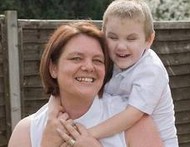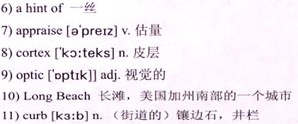文字难度:★★★
When bats go out to hunt, they send out 1)sonar signals at such high frequencies and in such rapid bursts that they can hear the signals bounce off mosquitoes in midair. They then 2)zero in on the insects like 3)laser-guided missiles. Dolphins use the same technique to find their dinners. It’s called 4)echolocation, a technique that uses sound to identify objects by the echoes they produce.
当蝙蝠外出觅食时,它们飞快地发出非常高频的声纳信号,这些信号碰到半空中的蚊子后反弹回来,蝙蝠马上就能听到。接着,它们便像激光导弹般瞄准那些昆虫。海豚使用同一方法来觅食。这一方法被称为“回声定位法”,是一种借助物体产生的回声来识别其方位的方法。
 Eighteen-year-old Ben Underwood of5)Sacramento is one of the people known to use “echolocation” as a primary means of navigating the world on land. There’s not even 6)a hint of light reaching his brain. His eyes are artificial, but his brain has adapted to allow him to 7)appraise his environment. He makes a “clicking” sound to communicate with objects and people around him.
Eighteen-year-old Ben Underwood of5)Sacramento is one of the people known to use “echolocation” as a primary means of navigating the world on land. There’s not even 6)a hint of light reaching his brain. His eyes are artificial, but his brain has adapted to allow him to 7)appraise his environment. He makes a “clicking” sound to communicate with objects and people around him.
来自美国加州萨克拉曼多的本·安德伍德今年18岁,是一位有名的主要以“回声定位法”驽驾陆地世界的人。他的脑子连一丝光线也感受不到。他的眼睛是假的,但他的脑子已调整适应过来,让他能估量自己所处的环境。他通过发出“咔哒”声来和物体以及他周围的人交流。
Scientists have discovered that in the brains of the blind, the visual 8)cortex has not become useless, as they once believed. When blind people use another sense—touch or hearing, for example—to substitute for sight, the brain’s visual cortex becomes active, even though no images reach it from the 9)optic nerve. Echolocation creates its own images.
科学家们已发现,盲人脑子里的视觉皮层并非如他们过去认为的那般没有用处。当盲人使用另一种官 能——例如触觉或听觉——来代替视觉时,其大脑的视觉皮层就会活跃起来,尽管它没有接收到来自视觉神经的影像。“回声定位法”能自创影像。
“I can hear that wall behind you over there. I can hear right there—the radio and the fan,” Ben says.
“我能听见在那儿,在你身后的那堵墙。我能听见就在那儿——有台收音机和风扇,”本说道。
Ben says every object in his life talks to him in ways that no one else can hear or understand.
本说,他生命中的每一个事物都以其他任何人无法听见或理解的方式和他交流着。
And Ben is not alone. Forty-four-year-old Daniel Kish of 10)Long Beach also uses echolocation and has become an expert on it. Actually, if you listen closely to Ben or Kish, you can hear how they find their way. Ben says he can distinguish where the 11)curbs are as he12)cruises his neighborhood streets. He can find the pole and the backboard on a basketball goal and tell which is which by the distinctive echo each makes. Even though he can’t see the goal he’s aiming for, he can sink a basket. Ben doesn’t remember how or when he began clicking, but he’s developed his abilities to such an extent that aside from echolocation, he can rapidly discriminate the sounds in video games.
而本并非个例。来自美国加州长滩的丹尼尔·克什今年44岁,他同样使用着“回声定位法”,并且已成为这一领域的专家。其实,如果你细细倾听本或克什的讲述,你就会听到他们是如何认路的。本说当他在附近的街道徘徊时,他能辨认出井栏在哪儿。在投篮时,他清楚篮球杆和篮板的位置,还能通过两者发出的不同回声来辨别哪是篮球杆,哪是篮板。尽管他无法看到他正瞄准的目标,但他可以投中球。本记不起他是如何以及在何时开始发“咔哒”声的,但除了使用回声定位法,他还大大提高其能力——已经能快速辨别视频游戏中的各种声音了。
 Ben lost his sight when he was two. He was diagnosed with cancer in both eyes, and when13)chemotherapy failed, his mother, Gordon, was left with one option: For her son to live, both his eyes had to be surgically removed. Gordon remembers her son after the operation.
Ben lost his sight when he was two. He was diagnosed with cancer in both eyes, and when13)chemotherapy failed, his mother, Gordon, was left with one option: For her son to live, both his eyes had to be surgically removed. Gordon remembers her son after the operation.
本在两岁时失明。他的两只眼睛被诊断为患了癌症。而当化疗失败后,他的母亲戈登只有一种选择:要让儿子活下来,则得通过手术摘掉他的双眼。戈登还记得她儿子在术后醒来的情形。
“He woke up and he said, ‘Mom, I can’t see anymore, I can’t see anymore.’ And I took his hands and I put them on my face and I said, ‘Baby, yes, you can see.’ I said, ‘You can see with your hands.’ And then I put my hand on his nose and I said, ‘You smell me? You can see with your nose and your ears. You can’t use your eyes anymore, but you have your hands and your nose and your ears.” In a house already filled with three other children, Ben’s mother decided not to treat his blindness as a handicap. In school, Ben recognizes his classmates by their voices. With the help of 14)Braille books and a talking laptop computer, Ben attends the same classes as sighted students.
“他醒来时说道:‘妈妈,我再也看不见东西了,我再也看不见东西了。’我抓起他的手,放到我的脸上,说道:‘宝贝,不,你能看见。’我说:‘你可以用你的手来看东西。’接着,我把我的手放在他的鼻子上,说道:‘你闻到我了吗?你可以用你的鼻子和耳朵来看东西……你不能再用眼了,但你还有手,还有鼻子和耳朵。’”家里还有另外3个孩子,本的母亲决心不把他的失明当成一种残障来看待。在学校里,本通过同学们的声音来辨别他们。在盲文书和一台有声手提电脑的帮助下,本和视力正常的学生们上着同样的课程。
Like Ben, Kish also lost his eyesight to cancer at age two. He was raised to believe he could do pretty much anything, and he discovered clicking by accident as a child. “I have mental images that are very rich, very complex. They simply do not possess the visual element,” Kish says.
和本一样,克什也在两岁时因患上眼癌而失明。他的父母在将他抚养成人的过程中令他相信了自己可以做很多的事,而他还是小孩的时候就无意间发现了“咔哒”声。“我的脑子里有丰富而极为复杂的影像。它们只不过没有对应的视觉元素罢了,”克什说道。
In 15)retrieving those pictures, Kish varies the pace and volume of his clicks as he walks along; and what he can tell you about an object’s qualities is sometimes astonishingly thorough.
为了重获那些画面,在行走时克什会不时改变他那些“咔哒”声的速度和音量。有时候他能详细精确地描述某个物体的特性,这的确让人惊讶万分。
If bats can distinguish 16)prey as small as mosquitoes with echolocation, and some dolphins can detect small targets a hundred yards away, what are the ultimate capabilities of human beings like Ben and Kish?
如果蝙蝠能运用“回声定位法”来辨别小如蚊子的猎物,而一些海豚能觉察出100码(约91米)以外的小目标,那么像本和克什这样的人其能力极限是什么?
“Ben clicks, looks to me like once every half second, whereas a dolphin is actually making 900 clicks per second. And the bat is even faster than that,” scientist says.
“我感觉本每过半秒就会发出一次‘咔哒’声,而海豚事实上每秒就发出了900次‘咔哒’声。而蝙蝠发出‘咔哒’声的频率甚至比这更高,”科学家说道。
It’s like a myth that blind people’s other senses compensate for their lack of sight. The thing is, blind people don’t have a more acute sense of smell, taste or touch; they can use their other senses or their other parts of the body more effectively and fully to feel and “see” the world.
盲人的其他官能补偿了他们失去的视力,这听起来很神奇。事实上,盲人并非比一般人拥有更敏锐的嗅觉、味觉或触觉,但他们能更有效和更充分地运用他们的其他官能或他们身体的其他部分,从而感受世界,“看”世界。




